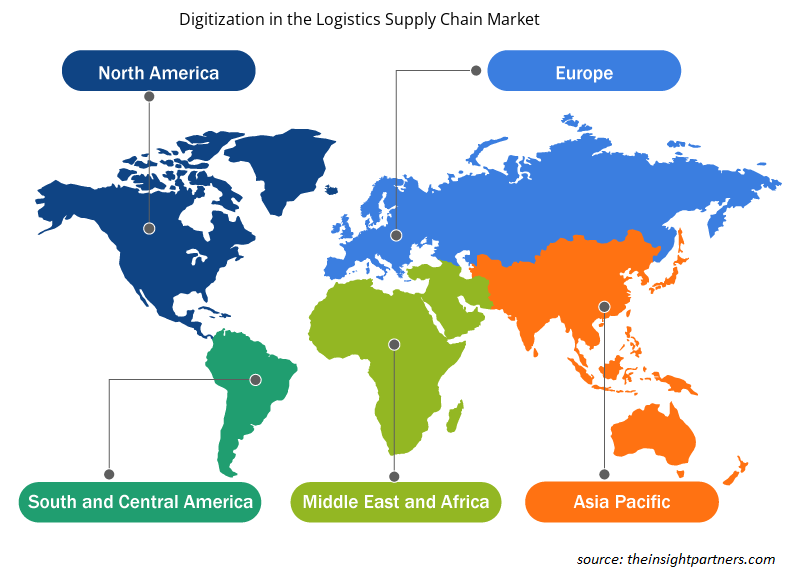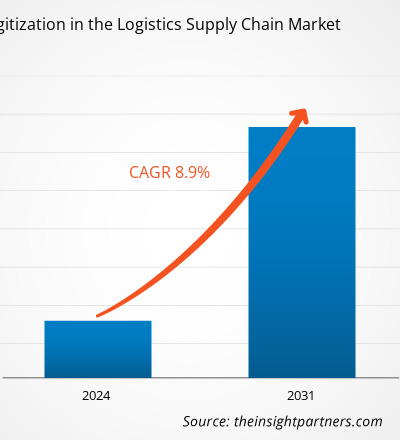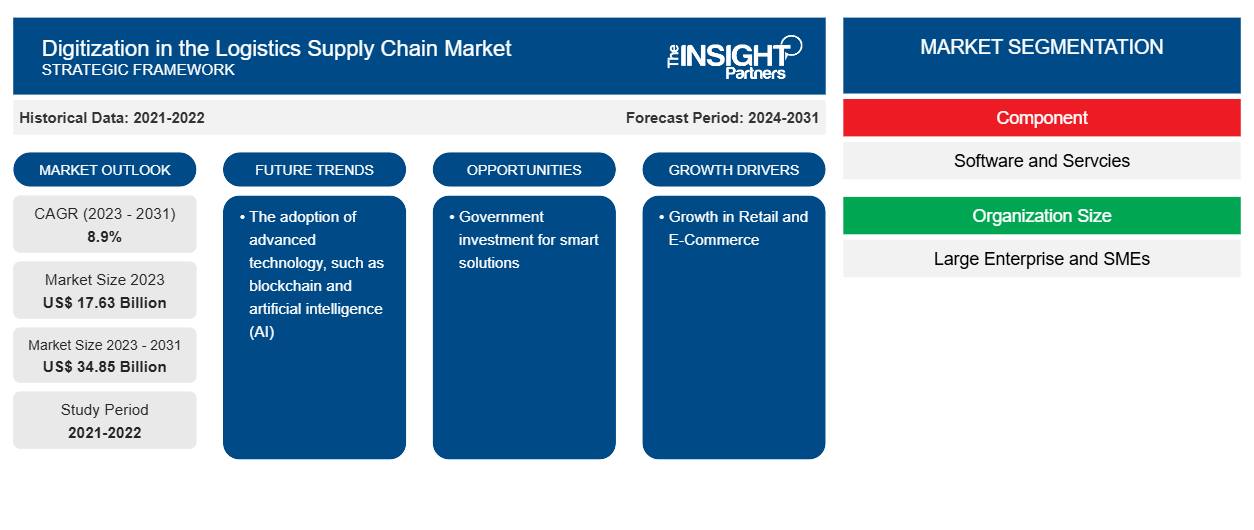물류 공급망 시장 규모의 디지털화는 2023년 176억 3천만 달러에서 2031년까지 348억 5천만 달러에 도달할 것으로 예상됩니다. 이 시장은 2023~2031년에 8.9%의 CAGR을 기록할 것으로 예상됩니다. 공급망 관리에 대한 수요 증가와 소매 및 전자 상거래 산업의 증가는 물류 공급망 시장 추세에서 핵심 디지털화로 남을 가능성이 높습니다.
물류 공급망 시장 분석의 디지털화
자동차, 소매 및 전자 상거래, 제조, 의료 등 다양한 산업에 걸친 자동화는 인적 오류를 줄임으로써 이러한 산업의 운영자에게 대규모로 이익을 제공했습니다. 예를 들어, 전 세계 소매는 지속적으로 성장하고 있으며 앞으로 더 많이 성장할 것으로 예상됩니다. 따라서 성장하는 소매 산업은 공급망과 물류의 재고 및 관리를 위한 수동 작업을 제거하여 총 운영 비용을 낮추는 데 중점을 두고 있습니다. 소매 산업 전반에 걸친 자동화 솔루션에 대한 수요가 시장을 촉진합니다. 여러 산업의 물류 부문은 이해 관계자가 오류 최소화, 향상된 운영 및 정시 납품을 지향함에 따라 디지털 변환을 목격하고 있으며, 이는 시장을 촉진하고 있습니다.
물류 공급망 시장의 디지털화 개요
디지털 혁신을 진행하는 것은 기존 비즈니스 모델을 보다 효과적이고 효율적으로 바꾸는 것입니다. 디지털 기술을 도입하면 여러 산업의 시장 참여자가 비즈니스 모델을 최적화하여 다른 참여자에 비해 경쟁 우위를 확보할 수 있습니다. 물류 공급망 운영을 디지털화하면 인력 비용을 절감하고 프로세스를 가속화하며 오류를 최소화할 수 있습니다. 인공 지능(AI)과 같은 보다 진보된 기술을 포함하면 고급 분석을 통해 효과적인 비즈니스 결정을 내릴 수 있습니다.
귀하의 요구 사항에 맞게 이 보고서를 사용자 정의하세요
이 보고서의 일부 또는 국가 수준 분석, Excel 데이터 팩을 포함하여 모든 보고서에 대한 사용자 정의를 무료로 받을 수 있으며 신생 기업 및 대학을 위한 훌륭한 혜택과 할인 혜택을 이용할 수 있습니다.
-
이 보고서의 주요 시장 동향을 알아보세요.이 무료 샘플에는 시장 동향부터 추정 및 예측까지 다양한 데이터 분석이 포함됩니다.
물류 공급망 시장의 디지털화 동인 및 기회
소매 및 전자 상거래 성장으로 시장이 유리
개인의 소득과 구매력 증가는 소매 및 전자 상거래 산업의 성장을 이끄는 주요 요인이었습니다. 모바일 보급률과 인터넷 연결의 증가는 소매 산업에 대한 실행 가능성과 쉬운 접근성을 제공하여 전자 상거래 산업의 성장을 이끌었습니다. India Brand Equity Foundation(IBEF)에 따르면 미국, 캐나다, 독일, 영국, 중국, 일본, 프랑스, 호주, 스위스, 이탈리아, 인도와 같은 국가는 강력한 소매 시장을 가지고 있습니다. 물류 공급망의 디지털화는 공급망의 이해 관계자가 운영을 최적화하는 데 도움이 됩니다. 디지털화는 공급망의 주문과 원자재를 실시간으로 추적하는 데 도움이 됩니다. 제조업체, 공급업체, 유통업체 및 소매업체 간의 효율적인 조정을 통해 비용을 절감하고 품질을 높이며 고객 요구 사항을 충족하는 데 도움이 됩니다. 따라서 소매 및 전자 상거래의 성장은 공급망과 물류 워크플로를 개선하기 위한 솔루션에 대한 수요를 촉진하여 물류 공급망 시장 성장의 디지털화를 더욱 촉진합니다.
스마트 솔루션을 위한 정부 투자 – 물류 공급망 시장의 디지털화 기회
전 세계적으로 디지털화를 촉진하기 위해 정부는 스마트 솔루션에 투자하고 있습니다. 스마트 솔루션을 도입하면 생산을 촉진하고 운영을 최적화하며 투자 수익을 높이는 데 도움이 됩니다. 복잡한 비즈니스 모델을 단순화하고 더 빠른 운영을 촉진하는 데 도움이 됩니다.
- 2023년 9월, 바이든-해리스 행정부는 스마트 교통 기술에 1억 6,000만 달러를 발표했습니다. 이 투자는 또한 배달 및 물류, 교통 신호, 스마트 그리드, 데이터 통합과 같은 시스템 혁신에 초점을 맞추었습니다.
- 2023년 2월, 인도 재무부 장관은 인도 전담 화물 회랑 공사(DFCC)에 약 33억 6,350만 달러(27,482억 루피)의 예산을 배정한다고 발표했는데, 이는 전년 대비 75% 증가한 수치입니다. 예산 연설에서는 항구의 마지막 및 첫 번째 마일 배송, 석탄, 철강, 비료, 식량 곡물 등 100개의 중요한 교통 인프라 프로젝트의 우선순위를 강조했습니다.
따라서 이러한 투자는 물류 및 공급망 부문의 디지털화를 촉진하고 시장 성장의 기회가 될 수 있습니다.
물류 공급망 시장 보고서 세분화 분석의 디지털화
물류 공급망 시장 분석에서 디지털화를 도출하는 데 기여한 주요 세그먼트는 구성 요소, 조직 규모, 산업입니다.
- 구성 요소를 기준으로 시장은 소프트웨어와 서비스로 나뉩니다. 소프트웨어 세그먼트는 2023년에 더 큰 시장 점유율을 차지했습니다.
- 조직 규모에 따라 시장은 대기업과 중소기업으로 세분화됩니다. 대기업 세그먼트는 2023년에 시장에서 가장 큰 점유율을 차지했습니다.
- 산업별로 시장은 소매 및 전자상거래, 의료, 제조, 자동차 및 기타로 세분화됩니다. 소매 및 전자상거래 부문은 2023년에 시장에서 가장 큰 점유율을 차지했습니다.
지역별 물류 공급망 시장 점유율 분석의 디지털화
물류 공급망 시장 보고서에서 디지털화의 지리적 범위는 주로 북미, 아시아 태평양, 유럽, 중동 및 아프리카, 남미/남중미의 5개 지역으로 나뉩니다.
수익 측면에서 북미는 물류 공급망 시장 점유율에서 가장 큰 디지털화를 차지했습니다. 미국, 캐나다, 멕시코는 북미의 주요 국가 중 하나입니다. 이 지역은 기술적으로 진보된 솔루션을 일찍 도입한 국가로, 이는 시장 성장을 주도하는 주요 요인 중 하나입니다. 이 지역의 소매 및 전자 상거래 산업의 증가는 공급망 및 물류 활동을 최적화하기 위한 디지털 솔루션에 대한 수요를 창출하여 시장을 육성합니다. 미국 상무부에 따르면, 2024년 2월 미국 소매 및 식품 서비스 매출은 2024년 1월에 비해 0.6% 증가했습니다. 또한 국제 무역 관리국에 따르면 캐나다는 2022년 캐나다 전체 인구의 약 75%의 전자 상거래 사용자를 보유했으며, 2025년까지 77.6%로 증가할 것으로 예상됩니다. 캐나다에서 온라인으로 물건을 구매하는 사람이 늘어나 제품 배달 작업과 같은 국가의 전자 상거래 활동이 증가하는 데 기여하고 있습니다.
물류 공급망 시장의 디지털화 지역 통찰력
Insight Partners의 분석가들은 예측 기간 동안 물류 공급망 시장의 디지털화에 영향을 미치는 지역적 추세와 요인을 철저히 설명했습니다. 이 섹션에서는 북미, 유럽, 아시아 태평양, 중동 및 아프리카, 남미 및 중미의 물류 공급망 시장 세그먼트와 지역에 대해서도 설명합니다.

- 물류 공급망 시장의 디지털화를 위한 지역별 특정 데이터 확보
물류 공급망 시장 보고서 범위의 디지털화
| 보고서 속성 | 세부 |
|---|---|
| 2023년 시장 규모 | 176억 3천만 달러 |
| 2031년까지 시장 규모 | 348억 5천만 달러 |
| 글로벌 CAGR (2023-2031) | 8.9% |
| 역사적 데이터 | 2021-2022 |
| 예측 기간 | 2024-2031 |
| 다루는 세그먼트 |
구성 요소별로
|
| 포함된 지역 및 국가 |
북아메리카
|
| 시장 선도 기업 및 주요 회사 프로필 |
|
물류 공급망 시장 플레이어 밀도의 디지털화: 비즈니스 역학에 미치는 영향 이해
물류 공급망 시장의 디지털화 시장은 소비자 선호도의 변화, 기술 발전, 제품의 이점에 대한 인식 증가와 같은 요인으로 인해 최종 사용자 수요가 증가함에 따라 빠르게 성장하고 있습니다. 수요가 증가함에 따라 기업은 제품을 확장하고, 소비자의 요구를 충족하기 위해 혁신하고, 새로운 트렌드를 활용하여 시장 성장을 더욱 촉진하고 있습니다.
시장 참여자 밀도는 특정 시장이나 산업 내에서 운영되는 회사나 기업의 분포를 말합니다. 주어진 시장 공간에 얼마나 많은 경쟁자(시장 참여자)가 존재하는지 그 규모나 총 시장 가치에 비해 나타냅니다.
물류 공급망 시장에서 디지털화 분야에서 활동하는 주요 기업은 다음과 같습니다.
- SAP SE
- 오라클 주식회사
- 아이비엠(주)
- 인텔 코퍼레이션
- 정보
- 헥사웨어 테크놀로지스 리미티드
면책 조항 : 위에 나열된 회사는 어떤 특별한 순서에 따라 순위가 매겨지지 않았습니다.

- 물류 공급망 시장의 디지털화를 위한 주요 업체 개요
물류 공급망 시장의 디지털화 뉴스 및 최근 개발
물류 공급망 시장의 디지털화는 1차 및 2차 조사 이후의 질적, 양적 데이터를 수집하여 평가합니다. 여기에는 중요한 기업 간행물, 협회 데이터 및 데이터베이스가 포함됩니다. 다음은 시장의 개발 목록입니다.
- 2023년 12월, 후지쯔는 공급망 전반의 운송업체, 물류 회사 및 공급업체를 위한 새로운 클라우드 기반 물류 데이터 표준화 및 시각화 서비스 출시를 발표했습니다. 이 서비스는 고객에게 운영의 지속 가능성을 달성하고 트럭 운전사 부족, 운송의 탄소 발자국을 줄여야 할 시급한 필요성, 더욱 엄격한 산업 규정 준수를 포함한 다양한 과제를 해결하기 위한 새로운 도구를 제공합니다. (출처: 후지쯔, 보도자료, 2023)
- 2024년 1월, 선도적인 공급망 솔루션 공급업체인 Blue Yonder는 회사 역사상 가장 큰 제품 업데이트 출시를 발표하고, 계획에서 창고, 운송, 상거래에 이르기까지 전체 공급망에 걸쳐 상호 운용 가능한 솔루션의 첫 번째 세트를 출시했으며, 이는 회사의 Luminate Cognitive Platform에서 제공되었습니다. 상호 운용성을 도입함으로써 Blue Yonder는 고객에게 생산성 증가, 낭비 감소, 보다 탄력적인 공급망을 제공할 수 있습니다. (출처: Blue Yonder, 보도자료, 2024)
물류 공급망 시장 보고서의 디지털화 범위 및 제공물
“물류 공급망 디지털화 시장 규모 및 예측(2021-2031)” 보고서는 아래 영역을 포괄하는 시장에 대한 자세한 분석을 제공합니다.
- 범위에 포함된 모든 주요 시장 세그먼트에 대한 글로벌, 지역 및 국가 수준의 시장 규모 및 예측
- 동인, 제약 및 주요 기회와 같은 시장 역학
- 주요 미래 트렌드
- 자세한 PEST/포터의 5가지 힘 및 SWOT 분석
- 주요 시장 동향, 주요 업체, 규정 및 최근 시장 동향을 포괄하는 글로벌 및 지역 시장 분석
- 시장 집중도, 히트맵 분석, 유명 기업 및 최근 개발 사항을 포함하는 산업 환경 및 경쟁 분석
- 자세한 회사 프로필
- 과거 분석(2년), 기준 연도, CAGR을 포함한 예측(7년)
- PEST 및 SWOT 분석
- 시장 규모 가치/거래량 - 글로벌, 지역, 국가
- 산업 및 경쟁 환경
- Excel 데이터세트
최근 보고서
관련 보고서
사용 후기
구매 이유
- 정보에 기반한 의사 결정
- 시장 역학 이해
- 경쟁 분석
- 고객 인사이트
- 시장 예측
- 위험 완화
- 전략 기획
- 투자 타당성 분석
- 신흥 시장 파악
- 마케팅 전략 강화
- 운영 효율성 향상
- 규제 동향에 발맞춰 대응























 무료 샘플 받기 - 물류 공급망 시장의 디지털화
무료 샘플 받기 - 물류 공급망 시장의 디지털화